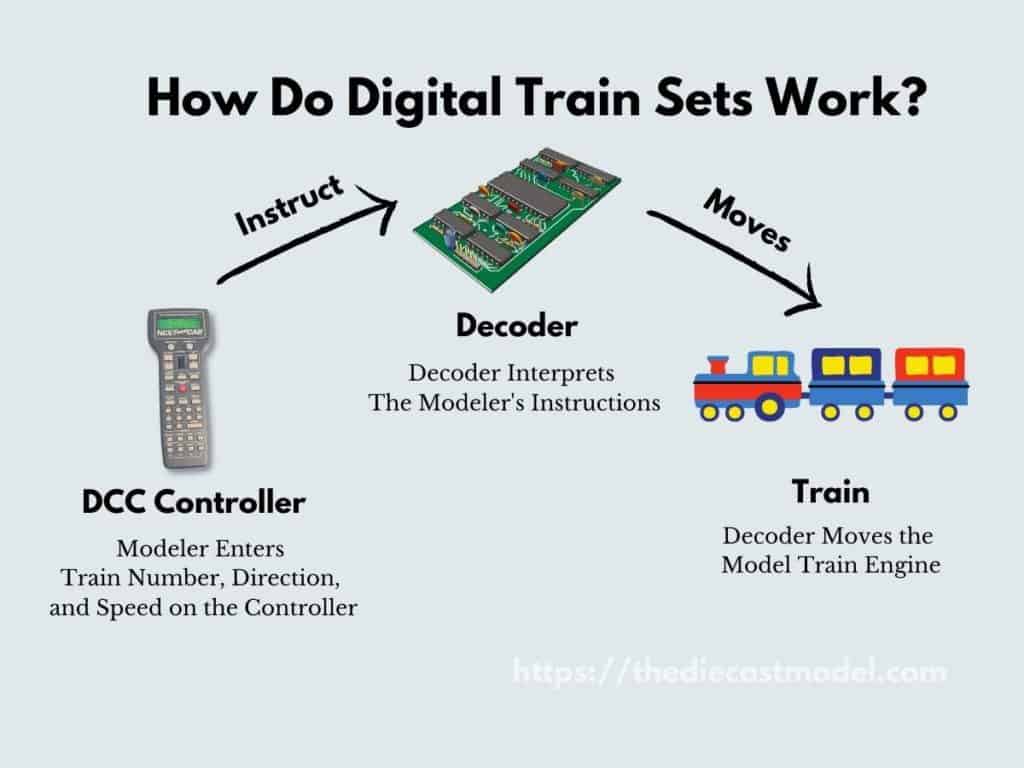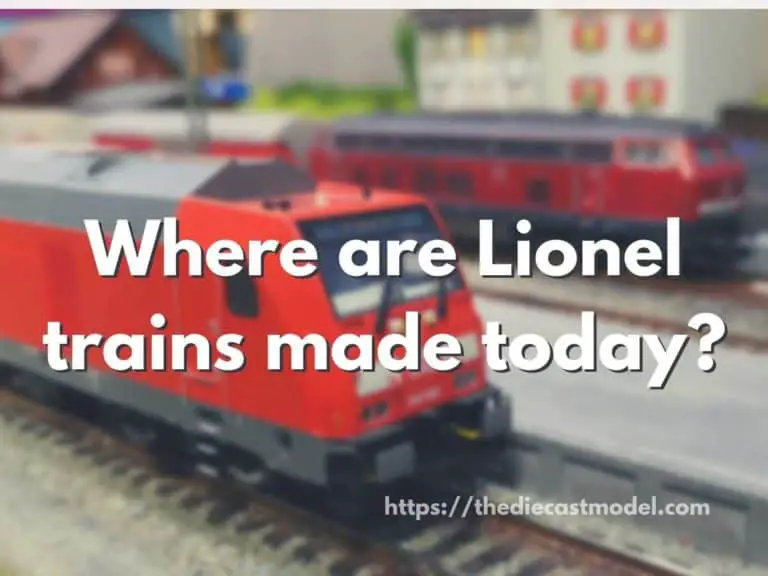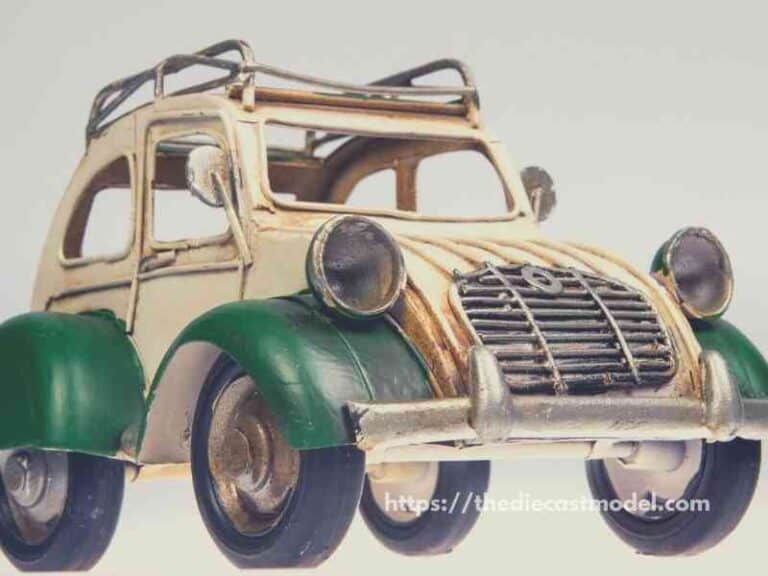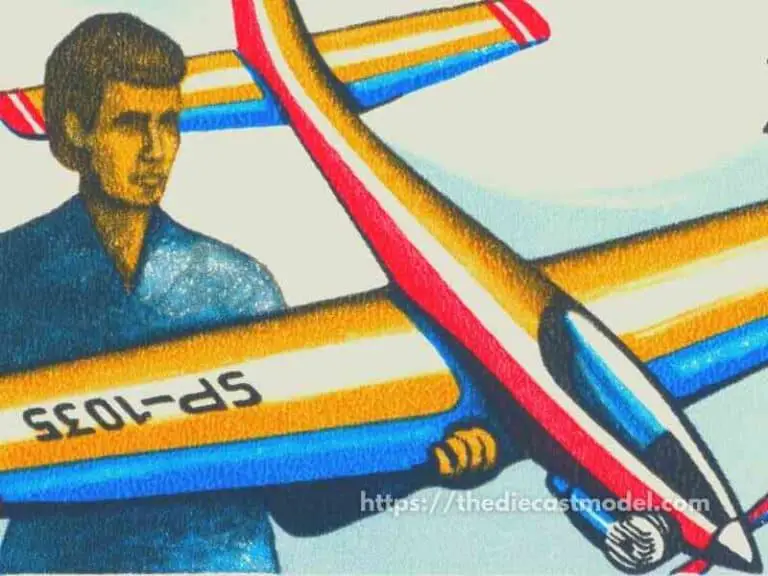How Do Digital Model Trains Work? A Look into DCC Controls
Have you ever wondered why some model trains can be controlled with a smartphone or a computer? These model trains are called digital model trains. While some models are controlled with analog controls that control the speed and direction, digital trains work differently. This post will discuss how digital train sets work and what makes them different from analog-controlled trains. So, how do digital model trains work?
Digital model trains work by using a decoder inside the train engine to interpret the modeler’s input on the controller, such as the train number, speed, and direction. The decoder then controls the train engine according to the values set by the user.
This post will discuss in detail how do digital train sets work. Furthermore, we will discuss how their controllers work and their difference from the standard analog train sets.

How do digital train sets work?
Digital train sets work by using a decoder to instruct the model train’s engine. This decoder interprets the values set in the controller which is placed by the user. The decoder can be controlled by either a DCC remote, a smartphone app, or a computer.
About 2 decades ago, most modelers used the analog system when controlling model trains.
However, with the rise of computers, digitally controlled model trains became possible.
But what urged people to upgrade to digital instead of analog controls they’ve used for a long time?
I think it’s best to answer the question with an example.
Imagine you’re new to train modeling and got the standard analog controls. However, the analog controls only have two variables which are speed and direction.
The analog control is also called the DC or Direct current control. It is called DC because it uses 12 volts of DC power to run the model train’s engine.
As a beginner, you can use this DC control freely and have no problems since you only have a simple layout and one train model.
However, what if you decided to upgrade your layout and bought more trains, rail, switches, and train accessories like bells and sounds.
Now, you try running these on your standard analog controls.
You’ll now notice that your two trains will run in the same direction at almost if not the same speed.
However, you want more stimulation and want one train to go straight and the other to go another way.
Furthermore, you want the rail switch to change so your two trains won’t collide on your layout.
Lastly, you might want your train to run lights and sounds even if it’s not moving.
Running this on an analog controller will not only involve a lot of work but will cost a lot since you need to properly control the power flow on your rails by using insulated rail joiners and power switches.
Furthermore, you need some AC power to run the accessories like its sound system.
The additional equipment needed to run a bigger layout would pile up the cost if you stay on an analog control.
Furthermore, this requires a lot of work as you try to control your layout.
However, is there a way to make things easier? Is there a way to control only one train while the one remains still? Is there a way to open the lights and sounds of the trains without running? To do that, we need the aid of the computer.
That’s where digital control can help. Instead of manually keeping an eye on your layout, you can instruct the computer inside the train on what to do.
Digital model train controllers have a tiny chip or computer inside the train which interprets the values set by the user.
This tiny chip or computer is what they call a decoder.
To make this possible, they changed the power source to AC instead of DC. This allowed trains to run lights and sounds even if the train wasn’t moving.
Furthermore, AC allowed its user to control the rails, such as controlling rail switches to change them without touching them.
Digital train sets eased the process of controlling complex layouts, and that’s why many people decided to switch from a simple analog to a digital layout.
So, how do model train controllers work?
Model train controllers work by having the user input essential values such as the locomotive number, direction, and train speed. These values are interpreted by a decoder inside the model train, which controls the engine.
Think of the decoder as your assistant in train modeling. This gives an identity to the train.
For example, you can instruct one of your assistants to go left while the other to go right. Thus, they will go different ways.
This is the same in train modeling, you can instruct one decoder to move on the right and one decoder to move on the left.
Thus, one model train will go left, and the other will go right.
You can also instruct one to stay still and the other to move. So, for example, you can order one to open its lights while staying still and the other to open its sound system while moving.
Digital or DCC controllers allow trains to be independent of each other and offer flexibility for better simulation of your layout.
It also allows less work for the person controlling the model.
The following section will dive more into the differences between the analog and digital train sets. But, first, you need to understand their basics to help you get a better grasp of how digital model trains work.
What is the difference between analogue and digital train sets?
The main difference between the analogue and digital train sets is that analogue uses DC power supply while digital uses AC power supply. Furthermore, digital train sets allow dependency over other trains since you can make trains go at a different speed and direction than others. Lastly, analogue requires less equipment to run compared to digital.
Here is a table summary of the differences between analog and digital train sets.
| Analog | Digital | |
| Power | Direct Current | Alternating Current |
| Other Name | DC | DCC |
| Accessories | Lights | Lights, Sounds, Rail Switch |
| Complexity on Simple Track | Less Complex | More Complex |
| Complexity on Complicated Track | More Complex | Less Complex |
| Wiring | Less Complex on Simple Layouts | Less Complex on Larger Layouts |
| Price | Cheap | Expensive |
For complete information regarding their differences, feel free to check this post: DC vs. DCC: differences and compatibility
Another thing to note on digital train sets is that they can be controlled with an app on the phone or computer since it is digital.
This means you can set the values on your phone, which is convenient.
This is called JMRI or Java Model Railroad Interface. This uses a computer language called Javascript to run the trains.
I won’t go into details on JMRI since it is not the main topic of this post. However, it is nice to know that what controls digital train sets is a computer language called Java.
That’s why digital train sets have a tiny computer inside the engine, and each locomotive needs a different computer or decoder to run.
This is the main argument why they always say that digitally controlled model trains are more expensive.
However, that is not looking at the whole picture.
A decoder costs around $20 each which can be expensive.
That’s why when having a simple layout with 1 train; analog controls are cheaper since you do not need to buy more types of equipment to run digital controls.
However, analog controls become more expensive than digital control when your layout becomes bigger with more trains.
This is because analog model trains require more equipment to run on complex tracks such as insulated rail joiners, power switches, and power packs.
Furthermore, each rail block would need these joiners, switches, and power packs, making it more expensive than digital controls.
That’s why on larger layouts, the digital command becomes cheaper. However, it is still more expensive if used on simple layouts.
I hope you learned a lot, and I invite you to read the recommended post below.
What’s next? Now that you know how digital train sets work how about learning how analog trains work, especially on multiple trains? Feel free to check this post to know more: Can you run two model trains on the same track?







